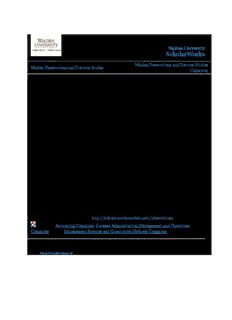
Budget Planning, Budget Control, Business Age, and Financial PDF
Preview Budget Planning, Budget Control, Business Age, and Financial
Walden University ScholarWorks Walden Dissertations and Doctoral Studies Walden Dissertations and Doctoral Studies Collection 2017 Budget Planning, Budget Control, Business Age, and Financial Performance in Small Businesses Tracy A. Foster Walden University Follow this and additional works at:https://scholarworks.waldenu.edu/dissertations Part of theAccounting Commons,Business Administration, Management, and Operations Commons, and theManagement Sciences and Quantitative Methods Commons This Dissertation is brought to you for free and open access by the Walden Dissertations and Doctoral Studies Collection at ScholarWorks. It has been accepted for inclusion in Walden Dissertations and Doctoral Studies by an authorized administrator of ScholarWorks. For more information, please [email protected]. Walden University College of Management and Technology This is to certify that the doctoral study by Tracy Foster has been found to be complete and satisfactory in all respects, and that any and all revisions required by the review committee have been made. Review Committee Dr. Roger Mayer, Committee Chairperson, Doctor of Business Administration Faculty Dr. Craig Martin, Committee Member, Doctor of Business Administration Faculty Dr. Julia East, University Reviewer, Doctor of Business Administration Faculty Chief Academic Officer Eric Riedel, Ph.D. Walden University 2017 Abstract Budget Planning, Budget Control, Business Age, and Financial Performance in Small Businesses by Tracy A. Foster MBA, Syracuse University, 2000 BSBA, Montana State University-Billings, 1992 Doctoral Study Submitted in Partial Fulfillment of the Requirements for the Degree of Doctor of Business Administration Walden University April 2017 Abstract Over 390,000 businesses failed in the United States in 2014. The primary cause for most business failures is poor planning, and budgets are a primary means of planning. The purpose of this correlational study was to examine to what extent, if any, budget planning, budget control, and the age of the business significantly predict financial performance in small businesses. The target population consisted of small business leaders in the Midwest. Churchill and Lewis’s theory on the relative importance of selected management factors of small businesses through 5 stages of development formed the theoretical framework for this study. Data were collected through a self-developed online survey using existing Likert-scale measures for each variable based on prior research about those variables. A convenience sample of 86 Midwest U.S. small business leaders identified through SurveyMonkey’s crowdsourcing pool resulted in 77 participants with useable responses. Standard multiple linear regression determined the extent to which budget planning, budget control, and age of the business predicted the value of financial performance. The model as a whole was able to significantly predict financial performance. The linear combination of predictor variables (budget planning, budget control, and business age) accounted for approximately 12% of the variation in financial performance. Budget planning significantly predicted financial performance, even when budget control and business age were held constant. Better planning using budgets may help leaders improve the financial health of their small businesses, potentially reducing business failures and job losses. Financially strong and healthy small businesses can create jobs and improve the economic health of local communities. Budget Planning, Budget Control, Business Age, and Financial Performance in Small Businesses by Tracy A. Foster MBA, Syracuse University, 2000 BSBA, Montana State University-Billings, 1992 Doctoral Study Submitted in Partial Fulfillment of the Requirements for the Degree of Doctor of Business Administration Walden University April 2017 Dedication I would like to dedicate this work to my wife, Laura, who has patiently provided unwavering support and encouragement to me, not only through this doctoral process, but countless other steps in this journey. Thank you for your confidence in me and your steadfast faith in our Lord and Savior Jesus Christ. It is only through Him and with your support that I could accomplish this milestone. Acknowledgments I would like to thank my chair, Dr. Roger Mayer, for his invaluable guidance and support throughout the doctoral process, as well as my former chair, Dr. Leslie Miller, who guided me through much of the proposal phase. I would also like to thank my committee member, Dr. Craig Martin, for his help throughout the entire process, and Dr. Julia East, whose feedback challenged me to improve my research and writing. Finally, I would like to thank my colleagues for their support and encouragement. Table of Contents List of Tables .......................................................................................................................v List of Figures .................................................................................................................... vi Section 1: Foundation of the Study ......................................................................................1 Background of the Problem ...........................................................................................1 Problem Statement .........................................................................................................2 Purpose Statement ..........................................................................................................2 Nature of the Study ........................................................................................................3 Research Question .........................................................................................................4 Hypotheses .....................................................................................................................5 Theoretical Framework ..................................................................................................5 Operational Definitions ..................................................................................................6 Assumptions, Limitations, and Delimitations ................................................................7 Assumptions ............................................................................................................ 7 Limitations .............................................................................................................. 7 Delimitations ........................................................................................................... 8 Significance of the Study ...............................................................................................8 Contribution to Business Practice ........................................................................... 9 Implications for Social Change ............................................................................... 9 A Review of the Professional and Academic Literature ................................................9 Application to the Applied Business Problem ...................................................... 11 Theoretical Framework ......................................................................................... 12 i Budget Planning .................................................................................................... 17 Budget Control ...................................................................................................... 23 Business Age ......................................................................................................... 29 Financial Performance .......................................................................................... 33 Budget Planning, Budget Control, Age of the Business, and Financial Performance .............................................................................................. 38 Transition .....................................................................................................................39 Section 2: The Project ........................................................................................................41 Purpose Statement ........................................................................................................41 Role of the Researcher .................................................................................................42 Participants ...................................................................................................................43 Research Method and Design ......................................................................................43 Research Method .................................................................................................. 44 Research Design.................................................................................................... 45 Population and Sampling .............................................................................................45 Ethical Research...........................................................................................................48 Data Collection Instruments ........................................................................................50 Budget Planning .................................................................................................... 51 Budget Control ...................................................................................................... 52 Business Age ......................................................................................................... 52 Financial Performance .......................................................................................... 53 Demographic Variables ........................................................................................ 53 ii Instrument Reliability and Validity ...................................................................... 55 Data Collection Technique ..........................................................................................55 Data Analysis ...............................................................................................................60 Statistical Analysis ................................................................................................ 61 Assumptions .......................................................................................................... 62 Interpreting Results ............................................................................................... 65 Software and Data ................................................................................................. 65 Study Validity ..............................................................................................................66 Internal Validity .................................................................................................... 66 External Validity ................................................................................................... 68 Transition and Summary ..............................................................................................69 Section 3: Application to Professional Practice and Implications for Change ..................70 Overview of Study .......................................................................................................70 Presentation of the Findings.........................................................................................70 Descriptive Statistics ............................................................................................. 71 Tests of Assumptions ............................................................................................ 74 Inferential Results ................................................................................................. 77 Applications to Professional Practice ..........................................................................80 Implications for Social Change ....................................................................................81 Recommendations for Action ......................................................................................82 Recommendations for Further Research ......................................................................83 Reflections ...................................................................................................................85 iii
Description: